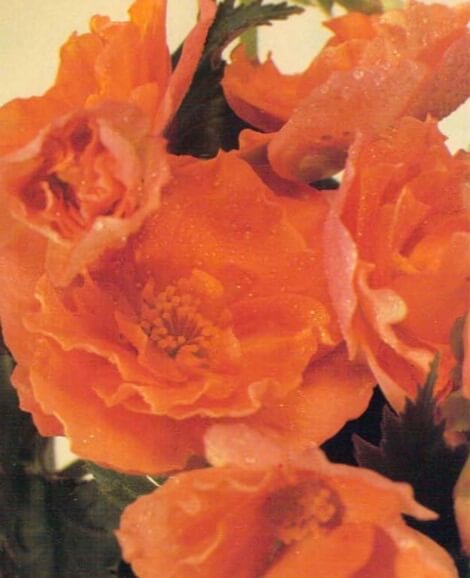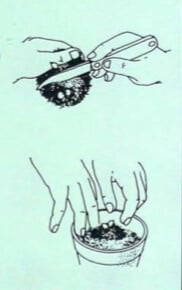[Ebook Việt Hoá] The Instant Guide to Healthy Houseplants (Hướng dẫn tức thời để chăm cây trong nhà khoẻ mạnh), Chi Begonia - Chi Thu Hải Đường
[Ebook Việt Hoá] The Instant Guide to Healthy Houseplants: Begonia tuberhybrida (Tuberous begonia)
- Nguồn: [Ebook Việt Hoá] The Instant Guide to Healthy Houseplants (Hướng dẫn tức thời để chăm cây trong nhà khoẻ mạnh)
- Biên tập: Dũng Cá Xinh
- Biên dịch: Team Codai.net
English
Begonias are old favorites among many houseplant growers. There are literally hundreds of different begonias, all of which fall into one of three main groups: those with fibrous roots, those with tubers (like small potatoes) and those with rhizomes (thickened underground stems). Tuberous begonias are descended from species introduced in 1865. Even today, hybrid varieties show traces of the foliage markings of Begonia pearcei, from which they originated. Tubers planted in early spring should develop later that season into young plants, which will flower in summer.

Light
Needs diffused light but not direct sun.
Temperature
Summer maximum, 70°F (21 °C); minimum, 60°F (16°C). In winter, store tubers in dry place at 50-55°F (10-13°C).
Water
Start watering dormant and divided tubers in early spring, watering whenever surface becomes dry. In summer, water copiously once a week as surface begins to dry. If temperature drops below 60°F (16°C), water only when surface is dry or tuber will rot.
Humidity
Spray weekly if temperature above 70°F (21°C). Stand pot on saucer of pebbles almost covered with water
Feeding
After flower buds form, feed monthly with liquid food diluted according to manufacturer’s instructions.
Soil
Plant new or divided tubers in equal parts peat and sand.
Repotting
Plant or repot tubers in early spring in 3- to 4-in (8- to 10-cm) pots. When shoots are 3-4 inches (8- 10 cm) long, repot into 4 to 5-in (10- to 13-cm) pots. In winter, when leaves have died down and soil is quite dry, remove tubers and store between layers of newspaper in a cool, dry place. As an alternative, tubers can be left to dry in their pots.
Cleaning
Not necessary, though may be dusted gently with soft brush. Use no leafshine.
Dividing tubers
- 1. Prepare 2 pots with mixture of soil and sand and cut tuber in half with sharp knife. Each section must include a shoot and roots.
- 2. Dust cut ends with sulphur dust and pot each separately, with half tuber above soil.

What Goes Wrong

- Too cold and wet: Move to warmer place, at least 60°F (16°C), and allow surface of soil to dry out before watering again. Thereafter, water only when surface of soil dries out; once a week in summer should be enough.
- Brown spots on flowers: Damage from water spray. Protect flowers with paper or your hand when spraying leaves. Remove damaged flower at base of stem.
- Leaves have black patches: Botrytis. Too cold and damp. Spray with fungicide, then place in warmer atmosphere and spray with water less often. Allow soil surface to dry out. Remove damaged.
- Flowers turn transparent: Damage from water spray. When spraying plant, protect flowers by shielding them with paper or your hand. Remove damaged flowers.
- Leaves small and no flowers appear: Needs feeding. After flower buds form, feed once a month with houseplant food diluted to manufacturer’s recommended strength. If leaves grow sparsely, the setting is too dark. Plant needs good diffused light to grow well and produce flowers.
- Brown scorch marks on leaves and flowers: Plant damaged by sunlight. Move into an area of diffused daylight, out of direct sun. Remove damaged leaves and flowers.
- Yellow patches on leaves: Begonia mite. Remove affected leaves and burn them. Dust plant with sulphur immediately, then once a month for 3 months.
- Leaves droop and dry up: Too hot. Move to cooler place with more ventilation. Spray daily with soft, tepid water, avoiding flowers. Maximum temperature is 70°F (21 °C).
- Stems become squishy: Plant too cold and damp or waterlogged. Check conditions and move to a warmer location, at least 60°F (16°C). Allow soil surface to dry out be- fore watering again and drain away any water from saucer below plant. If there are signs of mold, spray stems with
- Tips of leaves curl, plant flops: Too dry. Keep soil moist in summer, watering copiously once a week just as surface be- gins to feel dry.
Tiếng Việt
Thu hải đường là cây yêu thích lâu đời của nhiều người trồng cây trong nhà. Thực sự có hàng trăm loại thu hải đường khác nhau, tất cả đều thuộc một trong ba nhóm chính: loại có rễ xơ, loại có củ (giống như củ khoai tây nhỏ) và loại có thân rễ (thân dày dưới đất). Thu hải đường có củ có nguồn gốc từ các loài được giới thiệu vào năm 1865. Thậm chí ngày nay, các giống cây lai cho thấy dấu vết của các dấu hiệu trên tán lá của thu hải đường nơi chúng có nguồn gốc. Củ được trồng vào đầu mùa xuân sẽ phát triển vào cuối mùa đó thành cây non, sẽ ra hoa vào mùa hè.

Ánh sáng
Cần ánh sáng khuếch tán nhưng không cần ánh nắng trực tiếp.
Nhiệt độ
Tối đa mùa hè, 70 độ F (21 độ C); tối thiểu, 60 độ F (16 độ C). Vào mùa đông, bảo quản củ ở nơi khô ráo ở 50-55 độ F (10-13 độ C).
Nước
Bắt đầu tưới nước ở trạng thái ngủ và củ đã chia vào đầu mùa xuân, tưới bất cứ khi nào bề mặt khô. Vào mùa hè, tưới nhiều nước mỗi tuần một lần khi bề mặt bắt đầu khô. Nếu nhiệt độ giảm xuống dưới 60 độ F (16 độ C), chỉ tưới nước khi bề mặt khô hoặc củ sẽ bị thối.
Độ ẩm
Phun hàng tuần nếu nhiệt độ trên 70 độ F (21 độ C). Đặt chậu trên đĩa sỏi gần như phủ đầy nước
Bón phân
Sau khi nụ hoa hình thành, hàng tháng bón phân lỏng pha loãng theo hướng dẫn của nhà sản xuất.
Đất
Trồng củ mới hoặc chia củ trên than bùn và cát với các phần bằng nhau.
Thay chậu
Trồng hoặc thay chậu vào đầu mùa xuân trong chậu 3 đến 4 inch (8 đến 10 cm). Khi chồi dài 3 – 4 inch (8 – 10 cm), thay chậu vào chậu 4 – 5 inch (10 – 13 cm). Vào mùa đông, khi lá đã tàn và đất khá khô, bạn hãy loại bỏ củ và bảo quản giữa các lớp giấy báo ở nơi khô ráo, thoáng mát. Thay vào đó, củ có thể được để khô trong chậu của chúng.
Làm sạch
Không cần thiết, mặc dù có thể được phủi bụi nhẹ nhàng bằng chổi mềm. Không sử dụng xịt bóng lá.
Chia củ
- 1. Chuẩn bị 2 chậu với hỗn hợp đất cát rồi dùng dao sắc cắt đôi củ. Mỗi phần phải bao gồm một chồi và rễ.
- 2. Cắt kết thúc bằng rắc lưu huỳnh và mỗi chậu riêng biệt, với một nửa củ ở trên đất.

Những vấn đề có thể xảy ra

- Quá lạnh và ẩm ướt: Di chuyển đến nơi ấm hơn, ít nhất là 60 độ F (16 độ C), và để bề mặt đất khô trước khi tưới lại. Sau đó, chỉ tưới nước khi bề mặt đất khô đi; mỗi tuần một lần vào mùa hè là đủ.
- Đốm nâu trên hoa: Thiệt hại do phun nước. Bảo vệ hoa bằng giấy hoặc tay của bạn khi phun lá. Loại bỏ hoa bị hư hỏng ở gốc thân.
- Lá có mảng đen: Nấm. Quá lạnh và ẩm ướt. Phun thuốc diệt nấm, sau đó đặt trong không khí ấm hơn và phun ít nước hơn. Để cho bề mặt đất khô. Loại bỏ hư hỏng.
- Hoa chuyển sang trong suốt: Thiệt hại do phun nước. Khi phun thuốc cho cây, hãy bảo vệ hoa bằng cách dùng giấy hoặc tay che chắn. Loại bỏ những bông hoa bị hư hỏng.
- Lá nhỏ và không xuất hiện hoa: Cần bón phân. Sau khi nụ hoa hình thành, bón phân mỗi tháng một lần với phân bón pha loãng theo khuyến cáo của nhà sản xuất. Nếu lá mọc thưa thớt, không gian quá tối. Cây cần ánh sáng khuếch tán tốt để phát triển tốt và ra hoa.
- Vết cháy xém nâu trên lá và hoa: Cây bị ánh nắng chiếu vào. Di chuyển vào khu vực có ánh sáng ban ngày khuếch tán, tránh ánh nắng trực tiếp. Loại bỏ lá và hoa bị hư hỏng.
- Các mảng vàng trên lá: Mạt thu hải đường. Loại bỏ các lá bị nhiễm bệnh và đốt chúng. Rắc lưu huỳnh lên cây ngay, sau đó 3 tháng 1 lần.
- Lá rũ xuống và khô lại: Quá nóng. Di chuyển đến nơi mát mẻ hơn với thông gió hơn. Phun hàng ngày bằng nước mềm, loãng, tránh làm dập hoa. Nhiệt độ tối đa là 70 độ F (21 độ C).
- Thân cây bị héo úa: Cây quá lạnh và ẩm ướt hoặc úng nước. Kiểm tra các điều kiện và chuyển đến một vị trí ấm hơn, ít nhất là 60 độ F (16 độ C). Để cho bề mặt đất khô trước khi tưới lại và rút hết nước khỏi đĩa dưới gốc cây. Nếu có dấu hiệu của nấm mốc, hãy phun thân cây bằng
- Đầu lá quăn lại, tàn cây: Quá khô. Giữ ẩm cho đất vào mùa hè, tưới nhiều nước mỗi tuần một lần ngay khi bề mặt bắt đầu khô.
![[Ebook Việt Hoá] The Instant Guide to Healthy Houseplants: Begonia tuberhybrida (Tuberous begonia) [Ebook Việt Hoá] The Instant Guide to Healthy Houseplants: Begonia tuberhybrida (Tuberous begonia)](https://vn1.vdrive.vn/codai.net/2020/02/ebook-huong-dan-tuc-thoi-cham-cay-trong-nha-khoe-manh-25-begonia-tuberhybrida.jpg)


